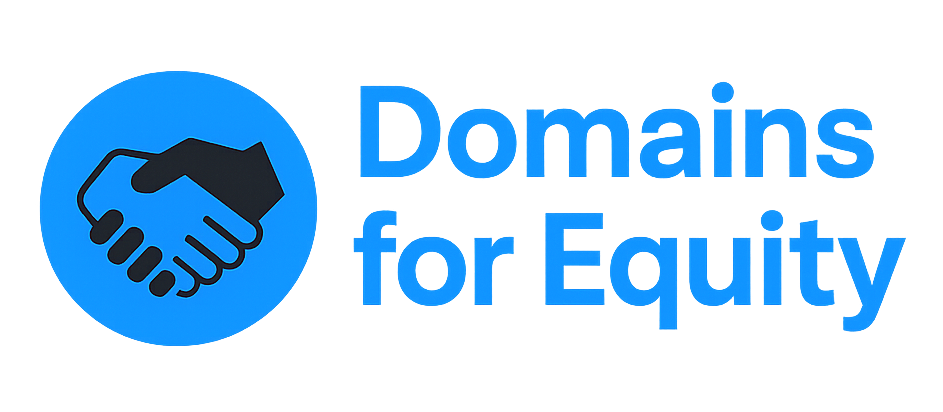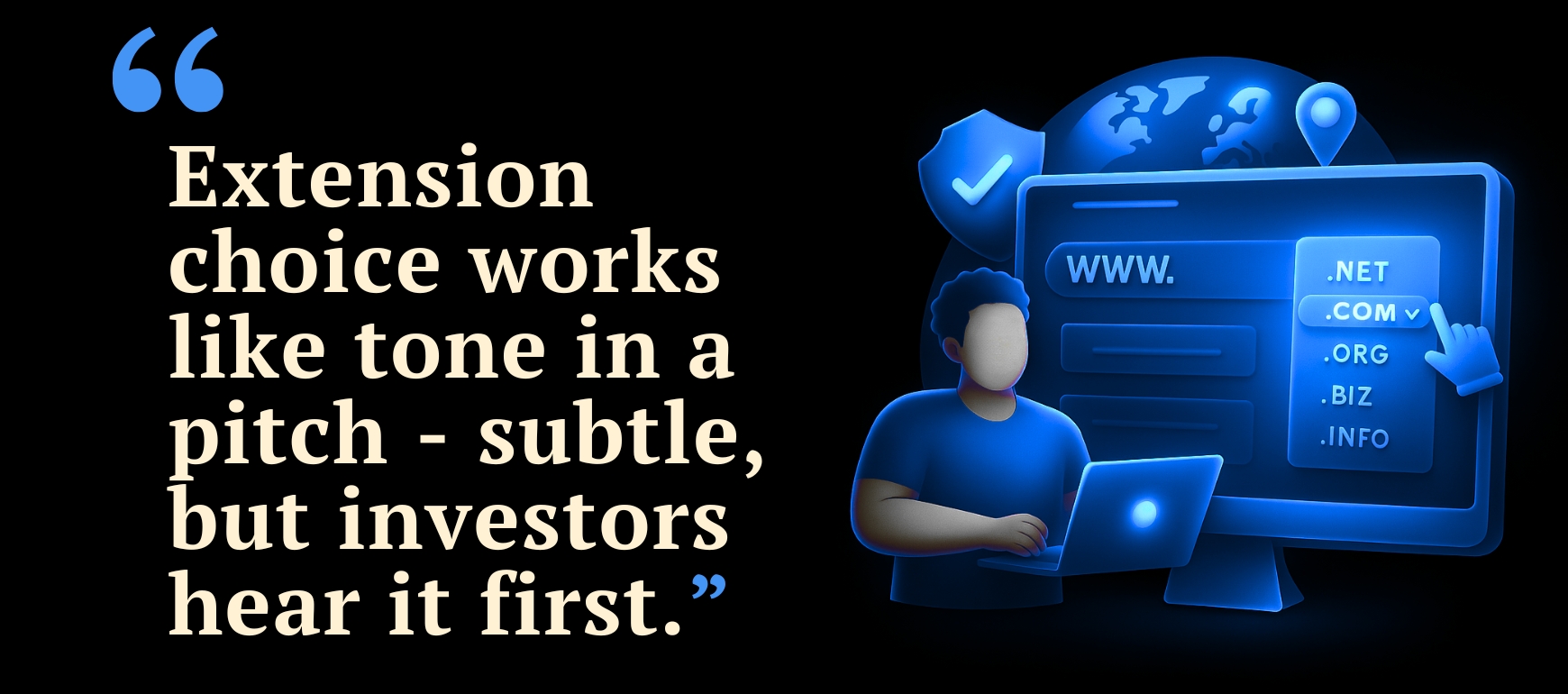Why Extensions Shape Investor Perception
When a founder unveils a product or sends the first investor deck, the domain name often speaks before the company does. Extension choice communicates scale, trust, and ambition in a single glance. In investor conversations, it functions like body language: subtle, immediate, and often decisive.
As Y Combinator co-founder Paul Graham noted, “if you have a US startup called X and you don’t have X.com, you should probably change your name,” because otherwise a marginal domain suggests… a marginal company.
The market has largely agreed. Data across funding rounds, consumer research, and resale markets shows a consistent bias: investors and users trust the classics. Roughly 70% of consumers place trust in .com domains (versus only ~26% for newer or obscure TLDs), and 96% of investors say their credibility judgments do depend on the domain extension. Verisign’s mid-2025 data illustrates this dominance.
The aftermarket confirms this through price discovery: Rocket.com sold for $14 million, and Icon.com for $12 million. Even strong alternatives in .ai or .io, extensions popular among tech ventures, rarely clear beyond the low seven-figure range. The pattern is consistent: investors continue to price recognition and global familiarity as core components of brand value.
Of approximately 371 million domain registrations worldwide, nearly 158 million sit on .com. Among 1,550 funded startups reviewed, over three-quarters chose a .com address. That choice isn’t nostalgia; it is liquidity and familiarity wrapped in one. The aftermarket reinforced it through price discovery: Rocket.com changed hands for $14 million, and Icon.com for $12 million. By contrast, popular among tech startups, extensions .ai and .io rarely reach the six figures. The pattern is clear: investors assign tangible value to recognition.
Marketing Efficiency and Capital Advantage
Domain name quality translates directly into marketing efficiency. A memorable name shortens recall, improves conversion, and reduces dependency on paid channels.
The founder of Dave, a fintech startup, shares that TryDave.com “just didn’t give [users] the same confidence” as Dave.com, and after switching signup rates climbed dramatically. The right domain boosted marketing ROI and even fundraising.
Jacob Beckerman, founder of the app Macro, says rebranding to Macro.com (a $600K investment) “gave us instant gravitas” and helped secure a seed round from a16z shortly thereafter. In his words, a great domain was “a powerful way to signal…credibility.”
From a financial lens, a trusted domain name behaves like goodwill: an intangible that enhances both perception and exit value. Settling for a weak or confusing TLD can raise doubts. Ultimately, domain name strategy can even influence exit value, think of Mint.com, where securing the single-word .com helped turn an equity stake into an $8.1M windfall at exit. The founder Jacob Beckerman said the new domain name “instantly projected credibility.”
ccTLDs: Local Credibility vs. Global Reach
Not all country-code TLDs (ccTLDs) are equal, but some can lend local credibility. In key markets, familiar ccTLDs often match or exceed .com in trust. For example, surveys show Canadian and Indian consumers find .ca or .in domains as credible as .com, and German or Australian users actually trust .de or .com.au more than .com. U.K. businesses often use .co.uk for local affinity, although younger audiences may still prefer .com.
Global reach tells a different story. A company using .co.uk or .in might enjoy local resonance yet face friction when scaling abroad. Founders seeking international growth often transition to .com or hold both versions simultaneously, using the country code for local campaigns and the .com for investor-facing communication.
Some country codes have evolved into tech shorthand. The .ai extension, originally from Anguilla, now signals artificial intelligence expertise. .io, derived from the British Indian Ocean Territory, connotes developer culture. .co acts as an accessible alternative to .com for early-stage companies. Each carries branding energy but also perception risk. Consumer surveys indicate lower trust among older or non-technical audiences, which can limit market penetration even when the brand feels trendy.
New gTLDs and Blockchain Names: Recognition Still Catching Up
The domain landscape has exploded past .com and country codes: thousands of new generic TLDs (ngTLDs) exist (from .app and .tech to .xyz and .club).Collectively, these new gTLDs accounted for only about 10.6% of all registrations. Many startups use them for aesthetic or keyword alignment, but investors and consumers still hesitate. Only a quarter of people, taking part in Atom’s research, say they trust new domains’extensions (like .biz, .site, etc.). Even with AI-favored .ai, only 4% of investors dismiss extension as irrelevant - meaning 96% do care - so choosing a trendy TLD still carries reputation risk
Web3-era extensions (e.g. .eth, .crypto, .nft on blockchains) are even less mainstream. These blockchain domains are popular in NFT and DeFi circles, but they aren’t generally used for a startup’s consumer-facing brand. For traditional founders, Web3 extensions function more as digital handles than market assets. They signal innovation but lack the universal visibility, governance, and trust that make .com and established TLDs commercially effective.
Comparative Overview of Extensions
| Extension Type | Typical Associations | Strengths | Constraints |
|---|---|---|---|
| .com | Global trust and permanence | Investor familiarity, resale liquidity, search preference | High acquisition cost, limited availability |
| ccTLD (.de, .ca, .com.au) | Local credibility and regulation alignment | Strong domestic recognition | Limited international scalability |
| Tech ccTLD (.io, .ai, .co) | Innovation and startup culture | Modern tone, availability of short names | Weaker consumer trust, resale volatility |
| New gTLD (.app, .tech, .xyz) | Keyword creativity, digital-native appeal | Branding flexibility, lower cost | Limited mainstream acceptance |
| Web3 (.eth, .crypto) | Blockchain and decentralized identity | Community relevance | Minimal regulation, poor visibility in traditional search |
Investor Logic and Naming Trends
Naming follows capital trends. The surge in AI ventures led to a measurable rise in .ai registrations, now representing over 12% of new tech startups. Yet the alignment must be authentic. When a non-AI company uses an .ai domain, investor curiosity may quickly turn to confusion. Extension choice should align genuinely with the company’s focus, ensuring the signal strengthens the narrative instead of competing with it.
Direct navigation behavior also underscores the resilience of .com. Users typing a brand name instinctively append .com, even when another extension exists. That automatic association drives organic traffic to whoever holds the .com version, leaving competitors on newer or alternative endings to compensate with higher ad spend.
For founders with global aspirations, .com remains shorthand for scale. A local enterprise, however, might extract more value from national identity. Some European fintechs thrive on .de or .fr addresses precisely because customers view them as native. The optimal strategy often blends the two: hold the .com for global communication and relevant local codes for geographic trust.
Final Thought: Domain Names as Strategic Capital
Every founder knows that perception shapes reality. Domain names influence marketing efficiency, fundraising outcomes, and even exit valuations. Investors read extensions the way credit analysts read ratios - quick indicators that compress complex judgments about risk and reliability.
While innovation may occasionally favor novelty, the evidence remains consistent: strong extensions align with investor confidence and customer conversion. Newer will mature in time, but Strategic-Grade domain names continue to anchor brand value across market cycles.
👉 Perception drives valuation. Post your request on DomainsForEquity.com and find a domain that communicates confidence and market readiness.

